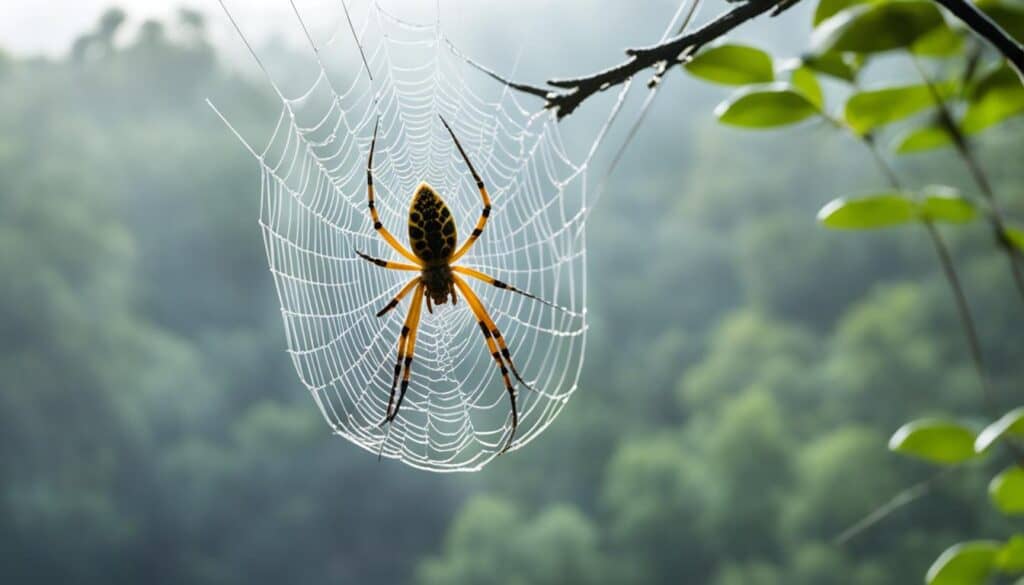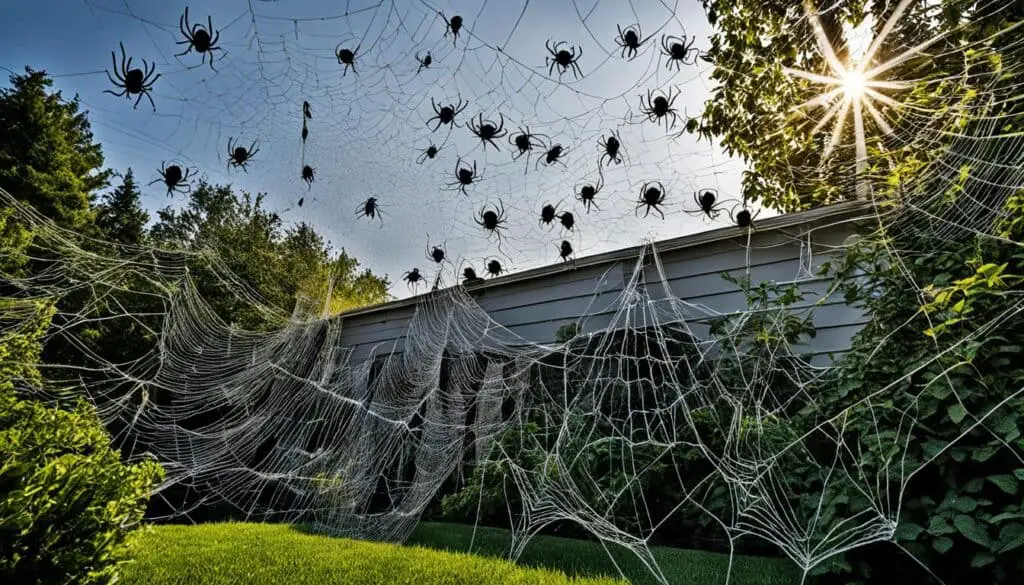Did you know Joro spiders can “fly” on wind currents for up to 100 miles? That’s right, these spiders with a 4-inch leg span are captivating the East Coast. People are buzzing about their unbelievable journey and unique features.
They were first seen in the U.S. in 2014. Since then, Joro spiders have settled in states like Georgia and the Carolinas. Even Maryland has reported sightings. New Jersey folks are watching out for these spiders. Though they look a bit scary, they are not dangerous to humans or pets. Their venom only targets the insects caught in their webs.
These colorful spiders love humid forests, similar to their homeland in Japan. If you see one of their intricate webs, just admire the craftsmanship. These spiders are making their mark on the East Coast with their flying and web-making skills. They are also quite peaceful.
Key Takeaways
- Joro spiders can travel up to 100 miles using wind currents.
- These spiders have a leg span of up to 4 inches and are impressive web-builders.
- Joro spiders prefer humid forest areas similar to their native Japan.
- Despite their venomous nature, their bites are harmless to humans and pets.
- First recorded in the U.S. in 2014, Joro spiders have rapidly spread across the Southeastern states.
- New Jersey is a hotspot for potential new sightings of these adaptable arachnids.
- Joro spiders’ ability to “fly” using ballooning is key to their widespread presence.
What are Joro Spiders?
Have you heard about Joro spiders? You might be wondering what they are. They’re big, with a leg span of up to 4 inches. Their bold yellow and black colors make them hard to miss. They go by the scientific name Trichonephila clavata.
Joro spiders came from Japan and Asia. They showed up in the U.S. (Georgia) in 2013. Since then, their numbers have exploded. They’re now all over the Southeast. Without help, they’d move about 10 miles yearly. But with their ballooning trick, they can travel up to 100 miles on the wind.
These spiders have a cool reaction to stress. They can stay still for more than an hour, like they’re pausing time. They also handle cold weather well. This shows they’re very tough.
Scientists are studying how they affect local ecosystems. They build huge webs, up to 10 feet wide. Although they have venom, they’re not a danger to people or pets.
Their presence is challenging for local wildlife. Experts are watching how this affects the ecosystem. These spiders are now in places like Alabama, Florida, and even Ohio. It’s surprising to see their large webs during a walk in Tennessee.
Joro Spider Behavior on the East Coast
If you’ve seen a giant spider on the East Coast, there’s no need to worry. It might be a Joro spider, which arrived in the U.S. in 2013. These spiders are known for their big webs and being seen often. They have quickly become a common sight.
Joro spiders prefer humid forests, similar to their home in Japan. They like to make these places their home and create webs. When they stretch their colorful legs, they can surprise people. Even though they have venom, their fangs can’t harm humans.
These spiders are quite calm. If something bothers them, they might stay still for more than an hour. They don’t mean to harm humans or pets. Instead, they catch bugs in their webs.
These spiders keep to themselves around people. They might startle someone with their webs but they don’t cause problems. They even manage to live near busy roads. Joro spiders have adapted to both forests and cities.
Next time you see a Joro spider, remember it’s not a threat. They show how nature can adapt and are often misunderstood. These spiders add to the East Coast’s ecosystem in their own unique way.
Spread and Invasion of Joro Spiders
Here’s a spooky spider story for you! The Joro spider invasion is causing worry in the southeastern U.S. They arrived from Japan in 2013 and Georgia saw them first. Now, they’re using their silk to fly and spread across the Southeast, as found in this study.
These spiders aren’t just known for their bright looks. They really stand out because they’re survivors. They have a heart rate 77% higher than similar spiders. Plus, their metabolism is twice as fast, helping them move into new areas quickly. They can even handle cold snaps better than their relatives.
At first, Joro spiders spread through Georgia fast. Now, they’re in states as far as Oklahoma and West Virginia. They’ve hitched rides with people to move around. Their spread is similar to their golden silk spider cousins from 160 years ago.
The Joro spider invasion isn’t just a tale— it’s a big deal for pest prevention and control. These adaptable spiders could end up living across much of the East Coast. They’re mostly not harmful to us or pets, but they’re still a bother.
What should we do next? It’s time to find smart ways to manage these spiders. We need community help and science-led policies. With the Joro spider invasion, we all need to be alert and ready.
Impact on Ecosystem and Humans
The Joro spider has made its presence known across America, stirring curiosity and concern. First spotted in Georgia in 2014, this spider has traveled to Tennessee, South Carolina, and Oklahoma. Considering the 60 nonnative spider species in North America, the arrival of the Joro spider raises questions about its effects on our ecosystem.
Though Joro spiders are venomous, their bites are unlikely to harm humans. Richard Hoebeke from the University of Georgia notes that their bites could cause minor symptoms. But, generally, these creatures are more afraid of us than we are of them.
They pose little danger to public health. Their ability to travel long distances through the air is noteworthy. They’re also cold-tolerant, which might enable them to spread north. This could be cause for concern.
These spiders might influence local economies, possibly affecting eco-tourism or pest control expenses. Yet, they help by eating invasive insects. But their overall impact on local ecosystems is still debated. Some research suggests they’re not harmful to native species, while other studies are inconclusive.
We’re learning to coexist with these spiders in urban areas. Experts suggest relocating them gently rather than killing them. As research continues, it appears these colorful spiders are here to stay. Learning to live with them is our new reality.
Conclusion
We’ve reached the story’s finale, where the Joro spider enters the East Coast scene. It’s a mix of ecological challenges and backyard discoveries. Imagine finding a massive spider lurking outside!
In Georgia, back in 2013, is where our tale begins. These spiders have traveled far in a short time. They’re setting their sights on new places, outdoing themselves. Their cousin, the Golden Orb Weaver, is also known but in warmer spots. Yet, Joro spiders are unique – they don’t mind the cold and are eyeing homes further north.
But there’s no need to panic. These spiders aren’t known to harm pets or people. Their webs add beauty to our surroundings. Plus, it’s amusing to see the huge size difference between male and female spiders.
As these spiders become more common, experts are closely watching them. We’re all learning and figuring out how to live with them. If you see one, let the local experts know. Our aim is to manage their presence carefully. For more info, check this article from Cornell University.




